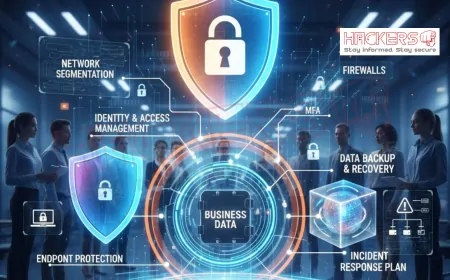Why Is the Aviation Industry a Prime Target for Cyber Terrorism?
Imagine a silent alarm going off in a control tower at 3 a.m. No explosions. No gunfire. Just a single line of code slipping into the airport’s network. Within minutes, flight schedules vanish, baggage systems freeze, and runways go dark. Planes circle endlessly above, fuel running low, while passengers panic on the ground. This is not science fiction. It is cyber terrorism, and the aviation industry is its perfect stage. In 2022, a ransomware attack on SpiceJet delayed hundreds of flights. In 2021, Air India’s data breach exposed 4.5 million passengers. In 2023, a major U.S. airport was hit by a DDoS attack that crippled online check-ins. These are not random hacks. They are calculated strikes on one of the world’s most critical systems. Why does cyber terrorism love aviation? Because one breach can ground a nation, sow fear, and cost billions, all without a single bullet fired. In this blog post, we will explore why airports, airlines, and air traffic control are prime targets. We will break down the motives, methods, and massive consequences of these attacks. Most importantly, we will show how the industry is fighting back. Because in the age of digital skies, security is not just about locks on doors. It is about defending the invisible networks that keep us flying.

Table of Contents
- Why Aviation Is Critical National Infrastructure
- What Is Cyber Terrorism in Aviation?
- The Motives: Fear, Chaos, and Leverage
- Entry Points: Where Hackers Get In
- Real-World Cyber Terrorism Incidents
- Air Traffic Control: The Ultimate Prize
- Passenger Data: A Goldmine for Identity Attacks
- Supply Chain and Third-Party Risks
- IoT and Connected Airports: New Vulnerabilities
- The Consequences: Beyond Financial Loss
- How the Aviation Industry Is Defending Itself
- Global and Indian Response to the Threat
- Cyber Terrorism Threat Matrix in Aviation
- Conclusion
Why Aviation Is Critical National Infrastructure
Aviation is not just travel. It is the heartbeat of modern society. Planes move people, medicine, food, and leaders. A single day of grounded flights can:
- Stop emergency organ transports
- Delay military troop movements
- Halt perishable goods like vaccines or flowers
- Block CEOs from global deals
- Prevent disaster relief teams from reaching crisis zones
In India, aviation supports 7.5 million jobs and contributes 5 percent to GDP. Airports like Delhi and Mumbai handle over 1,000 flights daily. One cyberattack can ripple globally in hours. That is why governments classify aviation as Critical Information Infrastructure (CII). A breach is not just a business problem. It is a national security crisis.
What Is Cyber Terrorism in Aviation?
Cyber terrorism uses digital attacks to cause fear, disruption, or harm for political, ideological, or religious goals. In aviation, it goes beyond stealing data. It aims to:
- Ground planes to create public panic
- Leak passenger lists to threaten VIPs
- Alter flight paths to cause collisions
- Disable air traffic control during peak hours
Unlike regular hackers who want money, cyber terrorists want headlines. They may be state-sponsored (like North Korea or Iran) or extremist groups. The 2016 Vietnam airport hack, which displayed political messages on screens, was an early warning. Today, the threat is silent, stealthy, and far more dangerous.
The Motives: Fear, Chaos, and Leverage
Why pick aviation? The payoff is massive:
- Psychological Impact: A grounded airport on TV terrifies millions.
- Economic Damage: One day of U.S. flight chaos costs $2 billion.
- Political Leverage: Threaten to leak a minister’s travel data.
- Media Amplification: Every delay trends on social media.
- Low Risk, High Reward: Hack from anywhere, no physical presence needed.
For terrorists, aviation is the ultimate soft target with hard consequences. A $10,000 hack can dominate global news for days.
Entry Points: Where Hackers Get In
Airports and airlines are full of digital doors. Common entry points include:
- Phishing Emails: A fake “urgent update” tricks staff into clicking malware.
- Unpatched Systems: Old software in check-in kiosks or baggage belts.
- Weak Wi-Fi: Public airport networks with no encryption.
- Third-Party Vendors: A small catering software firm with admin access.
- IoT Devices: Smart cameras, temperature sensors, or digital signage.
- Insider Threats: A disgruntled employee selling login credentials.
Once inside, hackers “move laterally,” jumping from a coffee shop Wi-Fi to air traffic control in hours.
Real-World Cyber Terrorism Incidents
These attacks prove the threat is real:
- Vietnam Airports (2016): Screens hacked to show anti-government slogans during APEC summit.
- Ukraine Power Grid (2015): Russian hackers cut electricity, showing aviation could be next.
- SpiceJet Ransomware (2022): Indian flights delayed for hours; could have been worse with political motive.
- London City Airport DDoS (2023): Website and check-in systems down for 48 hours.
- Iranian Hack on El Al (2024): Attempted data leak of Israeli passenger manifests.
Many attacks go unreported to avoid panic. But intelligence agencies say state actors constantly probe aviation networks.
Air Traffic Control: The Ultimate Prize
Air Traffic Control (ATC) is the brain of the sky. A breach here is catastrophic:
- Change flight altitudes to cause near-misses
- Delete radar blips, making planes “invisible”
- Send fake emergency signals to divert military jets
- Shut down voice comms between pilots and towers
In 2021, a fake ATC message in Pakistan nearly caused a mid-air collision. Modern ATC uses IP-based systems, easier to hack than old radio. India’s AAI is upgrading to NextGen ATC, but transition periods are vulnerable.
Passenger Data: A Goldmine for Identity Attacks
Airlines store your life in a database:
- Passport, Aadhaar, visa details
- Credit cards, frequent flyer miles
- Travel patterns, hotel bookings
- Emergency contacts, medical notes
A leaked list can be used to:
- Blackmail VIPs with travel history
- Create fake passports for terrorists
- Target families of military personnel
The 2021 Air India breach via SITA exposed 4.5 million records. If politically motivated, it could have been weaponized.
Supply Chain and Third-Party Risks
No airline builds all its tech. They rely on:
- SITA for passenger systems
- Sabre or Amadeus for bookings
- Caterers, fuel suppliers, ground handlers with network access
One weak vendor = total collapse. The 2020 SolarWinds attack showed how one compromised update infects thousands. In aviation, a hacked baggage firm can spread malware to the runway.
IoT and Connected Airports: New Vulnerabilities
Smart airports use thousands of connected devices:
- Biometric gates
- Robot cleaners
- Digital departure boards
- Smart lighting and HVAC
Many run on default passwords like “admin123.” A hacked camera can be a backdoor to the entire network. In 2023, a casino was breached via a fish tank thermometer. Airports are next.
The Consequences: Beyond Financial Loss
A successful attack causes:
- Safety Risks: Mid-air collisions or runway incidents
- Economic Collapse: $10 billion daily loss if U.S. skies shut
- Public Panic: Fear of flying drops tourism
- National Security: Leaked defense travel data
- Reputation Death: Airlines lose trust forever
In India, a 24-hour airport shutdown could delay 500,000 passengers and cost Rs. 1,000 crore.
How the Aviation Industry Is Defending Itself
Airlines and airports are fighting back:
- Zero-Trust Networks: Verify every user and device
- AI Threat Detection: Spot anomalies in login patterns
- Encrypted Comms: All pilot-tower talk secured
- Redundant Systems: Backup ATC in case of breach
- Cyber Drills: Simulate attacks with military
- Bug Bounties: Pay ethical hackers to find flaws
Delhi and Mumbai airports now have 24/7 Security Operations Centers (SOCs).
Global and Indian Response to the Threat
India is stepping up:
- NCIIPC: Protects airports as CII
- CERT-In: Issues aviation-specific alerts
- AAI Cyber Policy: Mandatory MFA, penetration tests
- DPDP Act 2023: Heavy fines for data leaks
Globally:
- IATA Cyber Security Toolkit
- ICAO mandates risk assessments
- EU’s NIS2 Directive for critical transport
Cyber Terrorism Threat Matrix in Aviation
| Target | Attack Method | Potential Impact | Defense |
|---|---|---|---|
| Air Traffic Control | IP spoofing, ransomware | Mid-air collision | Isolated networks, backups |
| Passenger Systems | Data breach via vendor | Identity theft, blackmail | Tokenization, encryption |
| Airport Wi-Fi | Man-in-the-middle | Credential theft | VPN, guest isolation |
| IoT Devices | Default password exploit | Network takeover | Device segmentation |
Conclusion
The aviation industry is a prime target for cyber terrorism because it combines high visibility, massive data, and life-or-death operations. One breach can ground planes, leak secrets, or cause collisions, all from a laptop thousands of miles away. From ATC to passenger apps, every system is a potential weapon. Real attacks in India, Vietnam, and beyond show the threat is live. But the industry is not defenseless. With AI, zero trust, and global cooperation, airports and airlines are building digital fortresses. In India, NCIIPC, CERT-In, and new laws are leading the charge. The message is clear: cyber terrorism wants chaos, but preparedness brings resilience. The next attack is coming. The question is not if, but whether we will be ready. For the safety of millions who fly every day, we must be. The skies belong to everyone. Let us keep them secure.
What is cyber terrorism in aviation?
Using cyberattacks to disrupt flights, steal data, or cause fear for political or ideological reasons.
Why is aviation a top target?
It causes maximum chaos, fear, and economic damage with minimal effort.
Can hackers crash a plane remotely?
Not directly, but they can disrupt navigation or ATC, increasing risk.
Is air traffic control hackable?
Yes. Modern IP-based systems are vulnerable if not isolated.
Was the SpiceJet attack cyber terrorism?
No. It was ransomware for money, not political motive.
Are Indian airports safe from cyber attacks?
Safer than before, but no system is 100 percent secure.
Can passenger data be used for terrorism?
Yes. To track VIPs, create fake IDs, or plan physical attacks.
Do terrorists hack airport Wi-Fi?
Yes. To…
What's Your Reaction?










































































